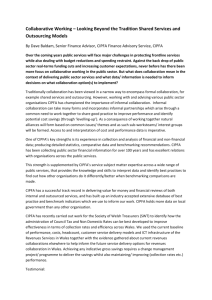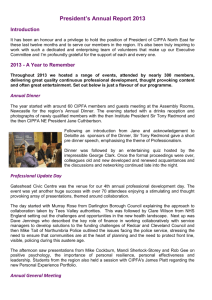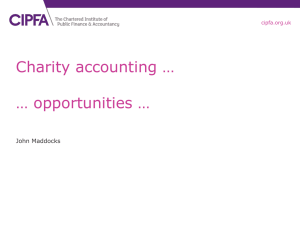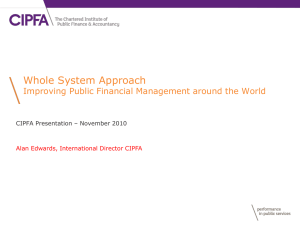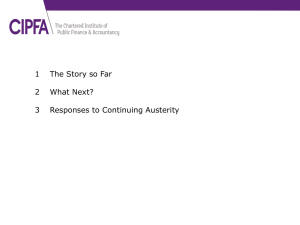CIPFA Financial Management Model V3 Latest Developments
advertisement
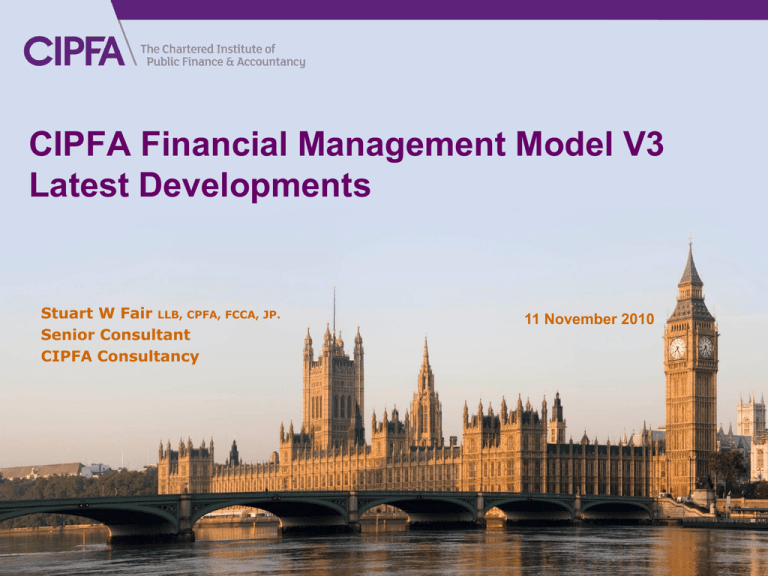
cipfa.org.uk CIPFA Financial Management Model V3 Latest Developments Stuart W Fair LLB, CPFA, FCCA, JP. Senior Consultant CIPFA Consultancy 11 November 2010 cipfa.org.uk Structure The Power of the FM Model Drivers behind changes to the FM Model CIPFA FM Model V3 – The Changes Specific Issues Functionality Summary cipfa.org.uk The Power of the FM Model cipfa.org.uk History Developed from 2004 Tested throughout UK Public Sector Created by a range of senior practitioners at CEO/FD level Version 2 launched in 2007 Version 3 to be launched January 2010 cipfa.org.uk Power of the FM Model Based on acknowledged good practice Spans entire spectrum of FM FM Strategy/Audit/Financial Reporting/Stakeholder confidence Wider than Finance Service Improvement on FM can be easily tracked Complements the NAO Maturity Model cipfa.org.uk Structure of the Model 38 Statements capturing the characteristics of good financial management A score is determined for each statement Each statement has supporting questions The questions assist in the scoring process cipfa.org.uk Users of the FM Model Central Government Departments Local Authorities Health Bodies Wales Audit Office Charitable Organisations Companies and other Delivery Bodies Government Finance Officers of America Abu Dhabi Accountability Authority cipfa.org.uk V3 – FM Model Central Government Lite Full FM Model for world wide application FM Model Lite developed for Central Government FM Lite is a sub set of full model shaped for most relevant Statements and Questions Core Statements plus added statements specific to the attributes of the organisation relative to complexity/delivery-policy/functionality context cipfa.org.uk Drivers behind the changes cipfa.org.uk Drivers behind the Changes Emerging Financial Landscape Development issues Customer experience Context – Third Iteration cipfa.org.uk Emerging Financial Landscape Unparalleled CSR cost reduction requirements Relentless focus on priorities: Significant Cost Reduction/Further Savings; Both within and between organisations; New and creative solutions - change and innovation must go hand in hand with robust stewardship. cipfa.org.uk Emerging Financial Landscape Beyond budget management – managers focus on managing their costs rather than budget Finance core to project/programme management and risk aware rather than risk averse Ensuring financial control without inhibiting the pace of change Efficiency techniques and mechanisms - lean processing, professional procurement, shared service; Greater requirement for finance staff to demonstrate commercial skills cipfa.org.uk Sharing Practice: Financial Management Capacity and Capability Are Central Government Departments focused on the financial management skills and competencies needed to operate effectively in the new environment? cipfa.org.uk Development Issues cipfa.org.uk Users of the FM Model – Central Government Central Government users including: HM Treasury Cabinet Office DEFRA Home Office Ministry of Justice Department for Works and Pensions Department for Children, Schools and Families Department for International Development Department for Communities and Local Government Foreign and Commonwealth Office UK Trade & Investment Export Credits Guarantee Crown Prosecution Service 8 – NDPBs/Executive Agencies cipfa.org.uk Common Findings – Central Government Stewardship/Governance generally strong Supporting Performance Patchy at best Transformational FM barely evident despite IT/Shared Services Investment People Management Dimension the weakest/Leadership the strongest cipfa.org.uk High Level Development Areas 1. 2. 3. 4. 5. 6. 7. 8. Value for Money Challenge and Culture Ownership of Financial Management Financial Management Competences Finance Function Service Standards & Performance Mgt. Positioning of Finance – Adding Value Linkage -Operational Performance and Financial Planning Forecasting – Re forecasting Financial management Information cipfa.org.uk Customer Experience Issues raised on : Scope of Statements – applicability/relevancy Terminology Electronic Survey functionality Reporting of Results cipfa.org.uk Context – Third Iteration since 2004 Principles of good FM unchanged but emphasis on: Risk management through change; Transactional efficiency and productivity; Collaborative working; and Commercial acumen of finance staff. cipfa.org.uk Version 3 - The Changes cipfa.org.uk Version 3 - The Changes 38 Statements of Good Practice Includes 3 New Statements Enhanced precision on Statements and Questions Stronger/Sharper evidence required cipfa.org.uk The Matrix of Good Practice Management Dimensions Financial Management Styles Leadership People Processes Stakeholders Securing Stewardship L1 - L2 P1 - P2 PR1 - PR11 S1 - S2 Supporting Performance L3 - L6 P3 - P4 PR12 - PR16 S3 - S4 L7 P5 - P6 PR17 - PR19 S5 - S6 Enabling Transformation cipfa.org.uk Issues Procurement – national (Green Report) and local Treasury Management – Icelandic Bank crisis Remuneration strategy – severance, pension liabilities Collaboration - VfM/cost reduction/pooling/shared services Affordability - Investment/Disinvestment Savings/Efficiencies/Value for Money Integration on Financial Strategies cipfa.org.uk Leadership – Added Focus Review on activity/actual spend, balance sheet, forecasting Strategy including Affordability/VfM/Risk Transfer Plans reflecting efficiency targets Key external cost drivers Strategic planning - affordability testing/cost and benefit Long term – strategic risk, resilience and financial standing cipfa.org.uk People – Added Focus Financial competency requirement Finance Function performance standards and monitoring Structure supporting Business Partnering Interpersonal skills from Finance Staff Help managers to anticipate problems/devise solutions Individual and collective responsibility re VfM cipfa.org.uk Processes – Added Focus Risk Management at all levels – Risk appetite Internal Audit risk based planning Transactional Financial Reporting – IFRS Compliance VfM – systematic opportunity for cost reduction Budget Management and Ownership cipfa.org.uk Budget Management – PR9 No surprises and leads to responsive action: Does the organisation provide clear documentation, support and guidance, so that Managers who are budget holders understand their responsibilities and own their budgets? Do Finance staff evaluate budget variances in terms of overall impact and risk for the organisation’s financial position and standing? cipfa.org.uk Stakeholder – Added Focus Transparency on spending – identification/responsibility Financial conduct - comment Service Performance – data quality validation External Ratings/Judgements/Reputation cipfa.org.uk Specific Issues cipfa.org.uk Impacts of Employee Remuneration – L6 People - biggest cost/component re cost reduction Sustainability of Pensions – current and future liabilities Strategic workforce planning Absenteeism and Sickness Pay progression – future payroll cipfa.org.uk Treasury Management – PR5 Treasury Risks – risk exposure control Liquidity – medium and long term Counterparty and interest rate risks – optimal risk management Borrowing and maturity arrangements Challenging Treasury Management advisors cipfa.org.uk Balance Sheet Management Sound and current platform for management action Period Movements reported at highest levels Asset valuations updated to reflect values and lives Impairment/Acquisition/Disposals/Depreciation/IFRS compliant Accurate Asset/Liabilities market values e.g. on Investments/Borrowings exposure Debtor – profile on status/age/legal process etc cipfa.org.uk Collaborative Working PR11/16/18 Complete picture on formal delivery – risk/rewards Evaluation of Financial Performance Reporting responsibilities and obligations Monitoring financial standing of key partners Linking Partners’ financials with MTFP Imbalance in strengths between Partners Sharing of Assets/Pooling cipfa.org.uk Procurement Procurement capacity and skilling Consistency on purchasing under formal contract Framework contracts, joint procurement or consortia Exploit economies of scale VfM from competition/supply chain mgt/ E-procurement – e-tendering/purchase to pay Optimal strategies – lease, buy or make cipfa.org.uk Medium Term Financial Management MTFP to include scenarios, risks and sensitivity analysis To reflect joint planning with partners and other stakeholders Long Term affordability Invest to Save/Disinvestment cipfa.org.uk Functionality cipfa.org.uk Functionality Electronic Survey Completion Electronic Survey Monitoring Reporting Capability Key Terminology changes - Central Government ‘language’ cipfa.org.uk Functionality Enhancements Contributor will only see relevant “culled” statements/questions Lead person can track survey completion by contributor Formatted Reporting of results for analysis Terminology friendly cipfa.org.uk Summary Need for strong Financial Management has never been greater CIPFA FM Version 3 - adapted for emerging financial landscape and latest good practice V3 Central Government Lite to be launched in early 2011 Enhanced FM Model can help organisations to address the seismic shift in expectations of Financial Management Questions Stuart W Fair LLB, CPFA, FCCA, JP. Senior Consultant CIPFA Consultancy No 1 Croydon 12-16 Addiscombe Road Croydon CR0 0XT Phone:01259 763592 Mobile:07919 558440 email :stuart.fair@cipfa.org.uk web :www.cipfa.org.uk/commercial cipfa.org.uk

